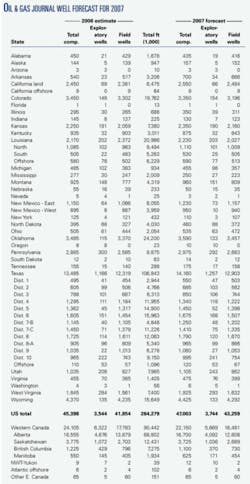Price uncertainty, especially for gas, overshadows the forecast for US and Canadian drilling in 2007.
Most signs seem to point to an increase in the US, although not as large as the 2006 gain. A drilling decline is forecast in Canada.
OGJ forecasts an 8% increase in the US active rig count to 1,780 rigs/week in 2007. This compares with increases of 19% in 2006 and 16% in 2005.
The unconventional gas plays that have been engaging increasing numbers of drilling rigs the past few years will soak up a few more rigs to be added to the fleet this year.
Here are highlights of OGJ’s early year drilling forecast for 2007:
- Operators will drill 47,003 wells in the US, up from an estimated 45,398 wells drilled in 2006.
- All operators will drill 3,744 exploratory wells of all types, up from an estimated 3,550 last year.
- The Baker Hughes Inc. count of active US rotary rigs will average 1,780 rigs/week this year, up from 1,649 in 2006 and 1,383 in 2005.
- Operators will drill 22,150 wells in western Canada, down from an estimated 24,105 wells in 2006.
State estimates
OGJ forecasts a 5% increase in Texas drilling in 2007 to 14,160 wells.
Wyoming, the next largest state in terms of numbers of wells, should see 4,425 wells drilled, including about 3,000 in the Powder River basin coalbeds alone.
The outlook is for 3,590 wells to be drilled in Oklahoma, up 3%, and 3,350 in Colorado, down almost 3%.
California land drilling is likely to be 2,550 wells in 2007, up from 2,450 in 2006. Another slight gain, 100 wells, is predicted in Kansas at 2,350 wells in 2007.
OGJ looks for the drilling of 2,230 wells in and off Louisiana. That includes 590, a slight increase, offshore in state and federal waters of the Gulf of Mexico. Another 120 wells are forecast to be drilled in the gulf off Texas.
Play activity
Drilling advanced in most areas of the US in 2006, with gains in a few states far exceeding the countrywide rig count average.
North Dakota’s 31 rig/week average in 2006 was up from 20 rigs/week in 2005 as drillers followed the Bakken horizontal oil play into North Dakota from Montana.
The Barnett shale play in the Fort Worth basin has seen some weakening as operators such as EnCana Corp. declined to pay strengthening rig rates, but the play is still expected to command 200 rigs/week in 2007 (OGJ, Dec. 18, 2006, p. 45).
Arkansas averaged 24 rigs/week in 2006 compared with 9 in 2005. Southwestern Energy Co.’s plan to drill 400-450 horizontal wells in the Fayetteville shale gas play in 2007 could foretell even busier rig activity in the eastern Arkoma basin.
Chesapeake Energy Corp., Oklahoma City, most active driller in the US, plans to operate as many as 150 rigs in 2007, up from 130 operated rigs in late 2006 when the company was participating in another 89 nonoperated rigs.
Chesapeake Energy said half its rigs are drilling to targets at 10,000-15,000 ft, a quarter to below 15,000 ft, and a quarter to shallower than 10,000 ft.
A relative latecomer to the Fayetteville shale play, the company operates 7 rigs there and is developing Little Creek field in White County, Ark.
Anadarko Petroleum Corp.’s 2007 development plan calls for drilling 280 wells with 8 operated rigs in Greater Natural Buttes gas field in the Uinta basin, Utah, and 280 wells with 5 rigs in Greater Wattenberg field in the Denver basin, Colorado.
Williams Cos., Tulsa, Okla., was operating 24 rigs drilling for Cretaceous Williams Fork gas in the valley and highlands parts of Colorado’s Piceance basin in November 2006 compared with 15 a year earlier. The company expected delivery of 6 more rigs by early 2007.
Meanwhile, Southwestern Energy said it plans to drill as many as 30 wells in 2007 in a new coalbed methane play in North Louisiana.
Outlook for Canada
Declines in drilling for shallow gas and coalbed methane should moderate drilling in Canada in 2007, especially in Alberta.
Many operators are poised to boost CBM drilling if gas prices strengthen.
A federal proposal to place a new tax on income trusts could put further economic pressure on the seismic, drilling, and service-supply sectors. There is some thought that taxing trusts the same as corporations could result in more field operations by trusts, which generally seek to grow by acquiring rather than drilling for reserves.
Incentives and a geologic leaning more toward oil than gas may insulate the province of Manitoba from drilling declines seen in the rest of the country. OGJ forecasts the drilling of 625 wells in Manitoba, up from 550 in 2006.


